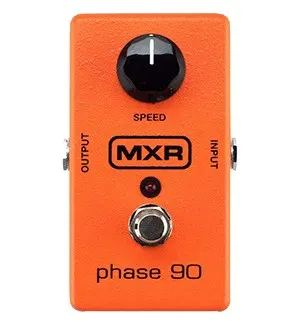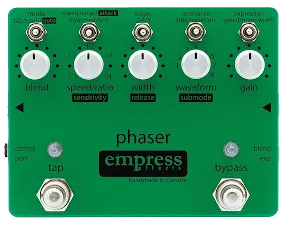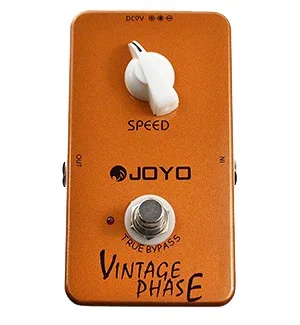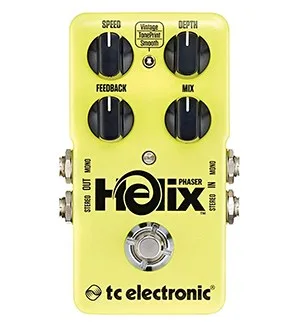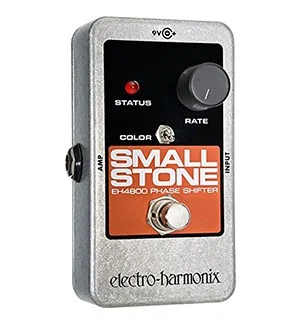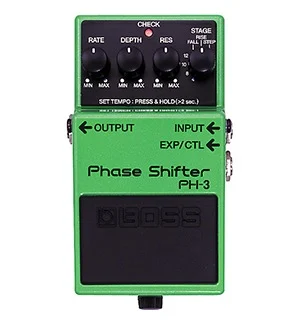The best phaser pedal can transport your listeners into another realm where magic still exists and frequencies slide back and forth in a psychedelically musical fashion. If you play rock guitar and don’t have one of these effects pedals in your pedalboard, you’re missing out on a classic way of captivating your listener’s and holding their attention…
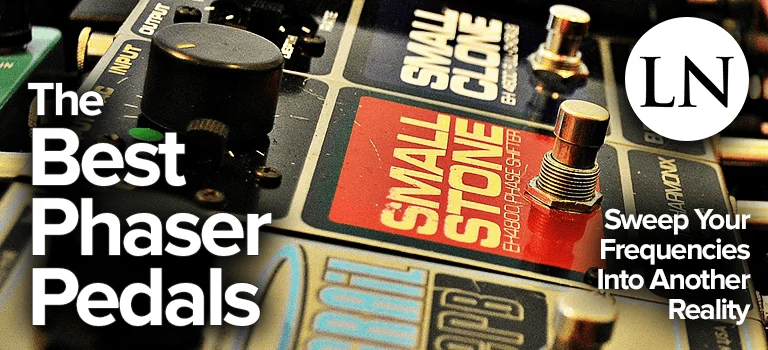
The phaser is among the earliest effects invented. It was actually invented as a way to emulate the sound of a rotating organ speakers and the phase shifting that comes along with that rotation.
The sound you hear when engaging one of these pedals is that of peaks and troughs being swept up and down the frequency spectrum, much like a flanger but subtly different.
It can be hardly noticeable, calm, and pleasing effect or a completely otherworldly experience for your listener. These pedals offer so many options today that the variations are nearly endless, so much so that you’ll hear it in many genres such as metal, rock, reggae, and even country music.
Often times, if you want to add a touch of spice to an otherwise vanilla sounding performance, a phaser is a great go-to to take it from boring to interesting, skipping all the in-between.
Need more information in order to better understand your needs? We have got you covered! Visit our FAQs section.
Included in this guide:
| MXR M101 PHASE 90 PHASER | Best Bang for the Buck | Buy on Amazon |
| EMPRESS EFFECTS PHASER PEDAL | Best of the Best | Buy on Amazon |
| JOYO JF-06 VINTAGE PHASE | Best Budget Pick | Buy on Amazon |
| TC ELECTRONIC HELIX PHASER | Most Versatile Pedal on the List | Buy on Amazon |
| ELECTRO-HARMONIX SMALL STONE NANO PHASER | Best for Those Who Looking for a Aarm Analog Phase Shifter | Buy on Amazon |
| BOSS PH-3 PHASE SHIFTER PEDAL | Best for Bridging the Gap Between Vintage & Modern Tones | Buy on Amazon |
The Best Phaser Pedals
Now that we’ve talked about which features to keep an eye out for and how to use phaser pedals in general, it’s time to head out into the marketplace and discover what the best choices are for our money.
We don’t order these in any specific way, but we do call special attention to our top pick as well as point out two other “best in class” options at the top of the article in the comparison table. Take the time to consider each, because if they made the list then they exceeded our expectations.
MXR M101 PHASE 90 PHASER
Let’s start with our “Bang for the Buck” pick, the MXR M101 Phase 90 Phaser. So why this one and not one of the other minimal phasers with only one knob? They’ve all sought to do one simple thing, which is cut down on moving parts and options to save the customer some money.
The difference with this one is it’s MXR and not a cheaper rip-off of some other brand being manufactured in China for a few bucks. MXR is now under the wing of Jim Dunlop, both of which are brands you can trust for their quality and craftsmanship.
The MXR Phase 90 has been on the scene for over 40 years now and is on the pedalboard of millions of guitarists in every genre. And it’s still around for a reason, because the demand is still there. Everyone wants the 100% analog warmth you get from the Phase 90’s rich tone.
The effect itself is timeless and a whole lot of people don’t realize they’re envisioning this pedal’s sound when they think of phase shifting. How many people learned of it through a Van Halen, or KISS, or Rob Zombie record? Well, that was the Phase 90.
Here is how I see this pedal. This is what you want when you decide you need a very good pedal, but you don’t want to break the bank on one with a million options. When all you want is a reliable phaser where you can tweak the speed of the effect without a ton of other distractions, this is it. This is the one to get.
Specs:
- Item Weight: 1 pound
- Signal Format: Analog
- Voltage: 9 V
Pros:
- Great build quality
- Easy to use
- Produces great sound
Cons:
- Not very versatile
EMPRESS EFFECTS PHASER PEDAL
Now you’re looking at the absolute big leagues. You’re looking at the best of both analog circuitry and digital processing offering you the warmth and richness of analog signal paths and the vast options provided by a microprocessor.
The Empress Effects Phaser Pedal is the next level, including an unparalleled low noise floor. You can choose from a 2, 4, and their exclusive 3 stage phaser modes, each with 8 selectable waveforms, all controllable through a tap tempo or speed knob.
You can get all of the classic jet plane, underwater, and outerspace sounds from phasing, but you can also dial in vibrato, ring modulators, Univibe, funky auto-wah, and much more. The 5 knobs and 5 switches give you tons of options to control, including choosing which knob the optional expression pedal controls.
But the coolest parts are the auto modes, including audio-triggered sweeps and rhythms, envelope following, and direct control.
There’s so many options here. Just consider the rate of the phasing. You can control it with the speed knob, tap tempo, a control voltage pulse, external audio, and even MIDI information. They covered the true bypass switching, too. And you can also blend the effect so it can be as wild as you want without masking your original signal.
This beast has it all, and neatly packs it away inside a rock solid enclosure you’ll never have to worry about. If you want the best and anything else would be a compromise, you’ve found the right option here.
Specs:
- Item Weight: 1.05 pounds
- Signal Format: Analog
- Voltage: 9 V
Pros:
- Great value for the price
- Quite versatile
- Has wide range of controls and options
Cons:
- Not simple to use
JOYO JF-06 VINTAGE PHASE
Take a look at this Joyo JF-06 Vintage Phase pedal, and then scroll back up to the MXR Phase 90 just above. That’s right. This Joyo is shamelessly based on the Phase 90, all the way down to the one knob and the orange colored enclosure, but gets it done a lot cheaper.
That’s why it’s our “Best Budget Pick,” because you’re getting as close to the Phase 90 as you can for less than half the cost. It’s kind of ‘not cool’ but at the same time there are serious guitar players that need access to a phaser but can’t afford to spend too much. We have to take the good with the bad.
Though this Joyo is fairly close to the Phase 90, it’s not exactly the same quality. But they did make one improvement to the vintage design that MXR chose to leave out, which was adding true bypass, so when it’s off it’s really off. You get the single Speed know to increase or decrease the rate of the phase shifting and that’s it.
It’s versatile enough that you can still get the faster underwater sounds or the slower and more subtle added character to your tone. This is for the player on a budget who wants the vintage Phase 90 sound without spending a fortune on an original model or springing for the official reissue.
Specs:
- Item Weight: 0.62 pounds
- Signal Format: Analog
- Voltage: 9 V
Pros:
- Convenient and compact
- Easy to use
- Has a warm analog sound
Cons:
- Limited range of effects
TC ELECTRONIC HELIX PHASER
Another great option out there that offers a bit more control over your effect is the TC Electronic Helix Phaser. It follows the philosophy of giving the musician more choices instead of keeping things incredibly simple and less distracting. There’s three core things to mention here.
You’ll have full control over your phasing with four knobs, including Speed, Depth, Feedback, and Mix levels. Having a Mix control is nice because it means you can have an extreme effect but drop it to a lower volume so your original tone still shines through versus it completely overriding your sound.
Having a Depth and Feedback knob is great if you really want to push your effect to the limit, creating really out of this world sounds. Keyboardists and synthesizer players will appreciate this the most, I assume but guitarists in far out genres can get a lot of mileage out of them as well.
Think about psychedelic rock, as an example. Notice that you also get stereo and mono inputs and outputs, so you can create an expansive, moving stereo field and take it to the next level.
The Helix Phaser also comes with TC Electronic’s TonePrint technology that allows you to download presets to the pedal. These presets are made by big name professional musicians and stored in the TonePrint library. You can download them to the pedal from your computer and you can even use your smart phone to beam the presets to the pedal using BlueTooth.
The way that works is it passes through your guitar’s pickups and down through your cable. That’s really wild. Check this one out if you like all of the options but don’t need anything too extreme.
Specs:
- Item Weight: 0.77 pounds
- Signal Format: Analog
- Voltage: 9 V
Pros:
- Versatile
- Has rich phase notes
Cons:
- Lacks harmonics of analog pedals
ELECTRO-HARMONIX SMALL STONE NANO PHASER
And now we’re back to another simple, but equally good, pedal called the Electro-Harmonix Small Stone Nano Phaser. Like many of the ones above, this pedal is a recreation of a classic and brought into the modern era. In 1970, the original Small Stone made a big name for itself and now it’s back with some improvements.
For one, it now includes true bypass switching which is almost a must have these days. It also has an LED status indicator so you’ll know if it’s on or not.
Like many simple phasers, you get a Rate knob to control the speed of the phasing sweep, but here you also get a Color switch. In the down position you get the type of effect you’ve come to expect, but in the up position you get a more pronounced sound.
You’ll hear that there’s gaps in the frequency spectrum with more obvious harmonics and fundamentals. What’s happening is the comb filters are made to be more thin while a Q filter carves out wider gaps between the resulting crests and troughs of the waves.
It’s built like a tank, sounds great, and very easy to use. For many, that’s all they want. If that sounds like you, then give this one some serious consideration.
Specs:
- Item Weight: 1.3 pounds
- Signal Format: Analog
- Voltage: 9 V
Pros:
- Great quality and affordable price
- Offers a broad range of sounds
- Compact and great build quality
Cons:
- Can have a bit of a clicking sound
BOSS PH-3 PHASE SHIFTER PEDAL
And now for another pedal that puts far more choices in the hand of the instrumentalist. The Boss PH-3 Phase Shifter Pedal bridges the gap between vintage and modern by offering you three phasing modes, including Step and the new Rise and Fall modes, plus multi-stage options as well.
Rise and Fall are both unidirectional, meaning they don’t sweep up and down, but start at the top or bottom and move in the opposite direction. They truly sound fantastic, as does anything Boss puts out. I love their solid enclosures and huge footswitches too.
Beyond those options, you’ll have full control over the Rate, Depth, and Resonance knobs. But that’s not where the luxury and convenience ends. You also get a tap tempo. You just hold the footswitch down for 2 seconds and then tap in time to the beat and you’re ready.
In addition, it has an expression pedal input so you can have real-time control over either the Rate, Depth, or Tempo. Boss is always a great choice where you can never go wrong. Give it a whirl!
Specs:
- Item Weight: 1.01 pounds
- Signal Format: Analog
- Voltage: 9 V
Pros:
- Great tone quality
- Simulated phaser stages offer excellent sound
Cons:
- A bit expensive
FAQs
In this section, we will discuss what phaser pedals are, and you’ll be fully equipped to make an informed decision. Let’s waste no time.
What is the Phaser Effect?
The phaser effect creates a slow sweeping sound up and down the frequency spectrum, very similar to the flanger effect, that resembles a swooshing sound within the original audio. This is achieved by duplicating the original audio and shifting its phase to create unevenly spaced notches in the frequency spectrum when recombined again.
The notches are uneven because the amount of phase shifting is dependent on the frequency being played. In a flanger the notches are evenly distributed because they’re created by a time delay instead of a phase shift.
The effect comes to life thanks to the low frequency oscillator used to alter the amount of phase shifting in general. This glides the notches up and down the audible spectrum to create the perception of swooshing within the original sound.
This effect gained popularity for the electric guitar and keyboard in the 1960’s when it became a staple of the psychedelic rock genre.
What to Look for in the Best Phaser Pedal?
Analog phasers have three stages of all-pass filters to generate the effect, but digital phasers can have far more stages simulated (you’ll see up to 12 and custom configurations too).
These ‘extras’ can get pretty crazy, but that’s why we’re looking for a phaser in the first place, so keep an eye out if you think you want to have more choices to toy with.
If you’d rather trust the manufacturer, you can find current analog pedals (that don’t necessarily sound vintage) that give you few options. Some, like the MXR Phase 90, only offer you a speed knob to change the rate of the phase shifting, while others add an intensity knob or tons more.
You can stay away from depth and resonance knobs if you want, especially if you know you’ll stick to the classic sounding settings and not experiment too much. Some have a tap tempo that you may be interested in.
The question is really just how crazy are you going to get with this effect? Because it can get far out or you can stick to the range of sounds that listeners expect to hear.
Phaser is one of those effects that makes me think of the saying, “just because you can doesn’t mean you should.” I keep this effect simple, but not always subtle, personally.

How to Use a Phaser Pedal
Phasers can be used alone or in combination with other effects. Mix it with a long delay and a volume pedal and you can swell out some really cool synth sounds.
Oddly enough they sound amazing with distortion. Extremely slow phasing can even sound like an auto-wah. But let’s not get ahead of ourselves. Here’s a look at this effect in isolation.
Where to Place it in the Signal Chain
Regardless if you’re using your amplifier’s effects loop, there’s still a logical and widely accepted method of linking your effects chain. It looks like this, from start to finish:
- Dynamics, Filters, & Pitch Shifters
- Boost & Distortion
- Modulation
- Time
Sequentially you’d want the phaser to go with the rest of the modulation effects like chorus and flanger pedals, which would just before your time-based effects like reverb and delay at the end of the chain.
Understanding the Knob Settings
Depending on the pedal, you’ll find various knobs. They will all feature a Rate or Speed knob, which affects how fast the phaser cycles. Some may offer a Depth setting to let you choose the intensity (amplitude of the notches).
Even more rare is the Form options that give you choices of what type of waveform you want to use. Other common knobs are Volume and Mix, giving control over the overall gain and the amount of effect to include with your original signal, respectively.
